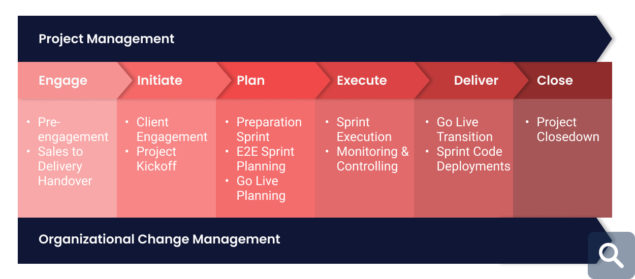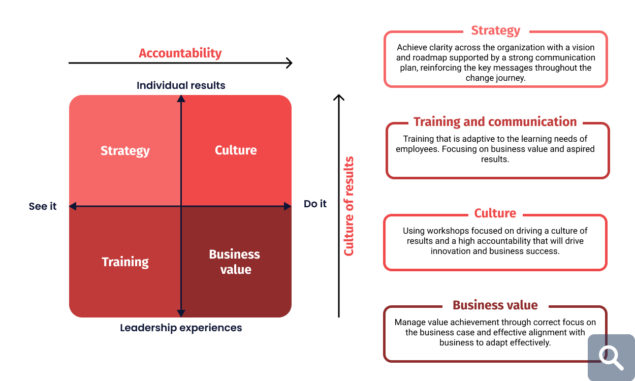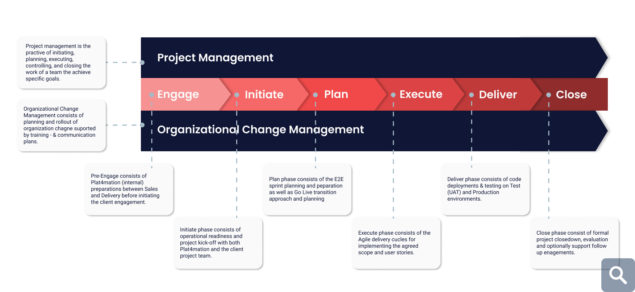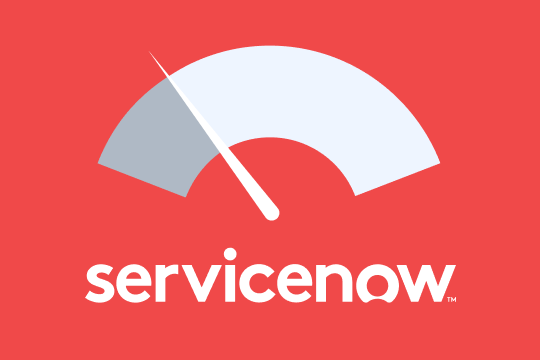Everything you need to know about a ServiceNow implementation
)
Quickly jump to:
- What is a ServiceNow implementation?
- Where to start your ServiceNow implementation journey - the key to successful implementation
- Using a delivery framework to maximize ServiceNow implementation value
- Why Organizational Change Management and Project Management are essential for your ServiceNow implementation
- How do you capture concrete business value when implementing ServiceNow?
- Customizations and your ServiceNow implementation
- The benefits of engaging a certified ServiceNow implementation partner
- Frequently Asked Questions about implementing ServiceNow
What is a ServiceNow implementation?
Implementing ServiceNow means fundamentally changing the way in which people work. To bring you the most value, any implementation – big or small – requires the careful balancing of people, process and technology.
But, where to start a ServiceNow implementation? What about the pitfalls? And what are the best practices?
Read how a sound and robust roadmap and implementation framework help deliver to the max on your business objectives. They enable you to put in place the best user experiences that bring the most value, even as your business develops and requirements change.
 hbspt.cta.load(5927535, ‘471fa1ef-0a17-435e-a364-7bd7ce4857e5’, {“useNewLoader”:”true”,”region”:”na1″});
hbspt.cta.load(5927535, ‘471fa1ef-0a17-435e-a364-7bd7ce4857e5’, {“useNewLoader”:”true”,”region”:”na1″});
Where to start your ServiceNow implementation journey - the key to successful implementation
Whereas most customers know what they don’t want, it can be a major challenge for organizations to define what they do want. Knowing where to start is critical in any implementation. A ServiceNow partner can help you define your fundamentals to kick-off your implementation journey and take it to a successful completion.
Whatever your ServiceNow implementation, follow the 5 stages below as how-to guide and as recommendations on which to base key decisions.
1. Connect vision and strategy to implementation
Your digital transformation is about creating the ultimate user or customer experience. Or is it? To know what you want out of your ServiceNow implementation, is also about knowing what type of experience you want to put in place.
As very basis of your implementation journey, this step involves drawing up a clear roadmap that connects your vision and strategy to implementation outcomes. What should you user or customer experience look like? What is your budget, your time frame and what are your own capacities and competencies? Such a roadmap brings guidance to thousands of decisions that need to be taken in a project. It will also help prevent you drift away from your pre-defined project scope.
Stating and measuring business goals
This step requires you to simply jot down the answers to four elemental questions:
- What is your vision?
- What are your strategic drivers?
- What are your desired business outcomes?
- What are the quantifiable key measures of success?
Clearly define and prioritize your short- and long-term ROI goals, and match them to your implementation priorities.
Building your business case in this way, will enable you to identify your quick wins and build a phased program. Similarly, using KPIs and data outcomes, you will be able to track performance and measure implementation success.
2. Map the right process foundations
Get the foundations right and you’ll get a clear view of what is needed for a successful implementation. This requires you to define your ‘as-is’ situation, as well as the desired ‘to-be’. In doing so, you will be able to clearly define the process and makes improvement visible, as well as where additions are called for. Providing answers to the following questions helps define your process foundations.
- What are the current processes and workflows and are they mapped? Mapping should include any gaps or potential redundancies. Have you developed process and workflow maps to help guide implementation?
- Do you have the necessary data model in place? Including streamlining of handoffs between systems, teams and individuals?
- Where can you realize most value through automation?
- What about the collection of redundant data?
- Are there gaps in standard adherence?
3. Set technology and data foundations
Key for a successful implementation is to define your baseline upfront. It’s essential you match your goals to current capabilities. Getting your data foundations right reduces the cost of future platform maintenance. And it will also help you make full use of platform capabilities.
To customize or not
Customization can be tempting and sometimes called for. However, customization can also mean increased maintenance costs in future, as well as feature upgrade issues. So, make out-of-the-box leading and customize only when and where strictly necessary.
CMDB – What to focus on
The critical foundation of your ServiceNow implementation is the CMDB. Key when modelling and populating your CMDB is to focus on relevance, not on comprehensiveness. In first instance, it’s about your business context, business goals and digital transformation objectives.
The questions that should be asked here are: Which configuration items do you need to define and track, to enable business outcomes and the supporting processes? Which capability data do you need for core identifiers, context, and controls?
Guard against future risk
Moving forward, you want to ensure your ServiceNow implementation continues to deliver value with minimal technical risk. You can support your implementation by defining a clear reference architecture for instances, integrations and data flows. Include specific mapping, guidelines and standards for partner implementations, as well as standards for security, performance, and customization.
4. Capture high-visibility, low-cost wins
Any implementation can falter or not deliver on value realization if there is no adoption or enthusiasm for what’s new among your users. Identifying and capturing quick win opportunities helps drive early adoption momentum.
4 ways to ensure quick wins to build adoption momentum and capture early ROI:
- Go for the low-hanging fruit – such as passwords, request management and more – that give you highly visible service experience improvements at low cost.
- In whatever you do, always make sure to respect your end users’ capacity to get used to any novelties or changes. In this way, you’ll speed up adoption. After all, users simply need time to figure out things that are new.
- Never over promise. It’s a simple way to avoid disappointing user experiences.
- Always identify lessons learned on any part of the implementation journey and use them to improve your solutions, drive change and manage any communications to your organization.
5. Engagement as driver for organizational change management
Even if you decide to do the implementation with the support of a ServiceNow partner, it still means your organization needs to be actively involved to ensure success.
This requires you to have in place foundational management capabilities, and also to ensure that everybody who is involved is aware of the scope and value of the implementation. In this respect, it is of great value to have responsible management present during the kick-off and give their vision to underline the choice for the ServiceNow implementation.
3 ways in which to boost engagement
- Be sure to have an executive sponsor who can remove roadblocks and work across silos. Such a sponsor doesn’t need any specific tech know-how in system implementation. He does need the authority and influence to promote change.
- Identify your stakeholders and set up train-the-trainer sessions where ‘champions’ are created. These are the people who must ‘spread the word’ and support the rest of the organization to implement and adopt ServiceNow. For this, you need both subject matter experts, as well as experts who can take on the technical maintenance of ServiceNow.
- Map ownership and give the right people the right responsibilities. Build roles and authorities, so that stakeholders can make the decisions that need to be made. Look beyond technical governance to include strategy and portfolio governance.
 hbspt.cta.load(5927535, ‘471fa1ef-0a17-435e-a364-7bd7ce4857e5’, {“useNewLoader”:”true”,”region”:”na1″});
hbspt.cta.load(5927535, ‘471fa1ef-0a17-435e-a364-7bd7ce4857e5’, {“useNewLoader”:”true”,”region”:”na1″});
Using a delivery framework to maximize ServiceNow implementation value
A solid delivery methodology is essential for a high-quality implementation with maximum value. Such a roadmap ensures your implementation activities deliver on your business case objectives, helps avoid pitfalls that impede success, and maximizes the ROI from your overall ServiceNow implementation.
The 6-step delivery framework, based on ServiceNow standards and our own best practices, provides an end-to-end approach. From engagement during the sales and delivery phase through to project closing, evaluation, and future engagements. All steps are driven by ongoing project management and organizational change management.
Why Organizational Change Management and Project Management are essential for your ServiceNow implementation
Organizational Change Management
ServiceNow offers the promise of improving the user experience. Above all, it’s an intuitive platform. But before embarking on any implementation, it’s essential to consider how implementations will impact the way your people work.
And, as we all know, any change in the way of working – also positive ones – can count on confusion and resistance of people who are comfortable with the ‘as is’ situation, and fear or are skeptical about the ‘to be’. Also, however intuitive the ServiceNow solution is, most users need a nudge to use it as best as possible.
All in all, this means that successful ServiceNow implementation and adoption calls for the creation of plans for change management, communication, and ownership.
Key is to focus on managing expectations and defining responsibilities. In doing so, you drive increased implementation value for your organization, including maximum user adoption, lower cost and greater business value.
Above all, it’s about getting your users to embrace ServiceNow and use the platform as intended. To achieve this requires true commitment by management to support such organizational change. Only then will you maximize value creation.
Project Management
Strictly speaking, project management is the practice of initiating, planning, executing, controlling, and closing the work of a team to achieve specific goals. But, typically, it is work that is never finished: there is always room for refinement and improvement.
By adopting an ongoing project management approach for your ServiceNow implementation, you continue to maximize value from the ServiceNow investment, even as your organization grows, matures, and adapts to shifting trends and market needs.
Such an ongoing project management approach can be achieved by regularly asking if changes in your implementation plan are still in sync with your roadmap? Is your data model fit for purpose, do your security requirements fit your use cases, and are you deploying ServiceNow in such a way that enables future growth or changes in your business goals?
It also involves revisiting your service strategy frequently and avoid repeating patterns that limit future opportunities. Make sure you get feedback from product owners and users. Check the assumptions that were made and desired benefits. What needs to be refined going forward? Do new ServiceNow feature releases bring new capabilities from which you can benefit?
How do you capture concrete business value when implementing ServiceNow?
The ServiceNow platform is unique in its flexibility and scalability. To get the most value out of your ServiceNow investment means constant monitoring and adaption, and further improvement and automation of workflows during implementation.
An Agile work method will help you maintain the flexibility needed to do just that. Because such an approach places:
- Individuals and interactions over processes and tools
- Working software over comprehensive documentation
- Customer collaboration over contract negotiation
- Responding to change over following a plan
In prioritizing implementation goals and issues in this way, it is easier to assess which elements cause the least friction, but create the most value for your business.
An Agile approach that fosters test driven development enables continuous improvement. In this way, even after the implementation phase – as your business needs change and develop – you will continue to improve and capture even more value on your ServiceNow investment.
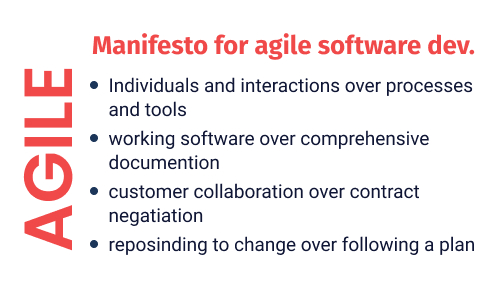
Customizations and your ServiceNow implementation
ServiceNow is a surprisingly broad platform. With many out-of-the-box solutions. Of course, it makes sense to stay as close as possible to out-of-the-box, not only regarding time, effort and cost of implementation, but also to safeguard future maintenance, optimization and security.
However, sometimes clients have use cases that apparently go way beyond out-of-the-box. At this point, it can be worth the effort to take a closer look at what can be built in ServiceNow based on best practices. The insights and experience of a ServiceNow partner can be of considerable added value in this process. Often, it turns out that closing the gap is easier than first thought. Which means that sticking to out-of-the-box ServiceNow solutions is the way to go after all.
The benefits of engaging a certified ServiceNow implementation partner
When you implement ServiceNow, the experience of a certified ServiceNow partner who knows everything there is to know about both best practices and implementation pitfalls, can bring you considerable benefits. For starters, they can help minimize overall project risk and speed up implementation.
Such a trusted advisor can provide a bigger picture and advise you regarding your ServiceNow implementation and digitalization roadmap. Which elements can best be done with ServiceNow and where do you need other solutions?
Taking your view
It is recommended to involve a partner early in the sales cycle, even before the purchasing stage. They can advise you which licenses you need and avoid them going to waste by ending up unused on the shelf.
What’s more, by involving a partner at an early stage, you can kick off your implementation quickly, as soon as the licenses start. A trusted partner offers a proven implementation approach that fits your needs. Such a proven framework sticks to ServiceNow out-of-the-box solutions, with tailored options to match your unique organizational requirements.
Taking a broader view
And because your partner has been involved in the whole purchasing decision, they also know it isn’t just about the tooling. It’s also about people and processes. What is needed to guide organizational change management?
For instance, they can help carry out stakeholder mapping at a very early stage. By involving stakeholders right from the outset, they can help define their definition of value and provide feedback during the implementation phase and afterwards.
Don’t forget that after go-live, much remains to be done to keep things optimized, upgraded and up and running. Having a partner to support you in these endeavors helps you establish a robust and ongoing support strategy.
 hbspt.cta.load(5927535, ‘471fa1ef-0a17-435e-a364-7bd7ce4857e5’, {“useNewLoader”:”true”,”region”:”na1″});
hbspt.cta.load(5927535, ‘471fa1ef-0a17-435e-a364-7bd7ce4857e5’, {“useNewLoader”:”true”,”region”:”na1″});
Frequently Asked Questions about implementing ServiceNow
What are the most common ServiceNow implementations?
ServiceNow has grown from an IT Service Management solution to a platform that can be implemented organization wide. About 65% of our initial customers begin with ServiceNow as IT Service Management solution. It’s an obvious starting point for implementation.
What ServiceNow solutions or modules are best implemented first?
As said, most organizations start with IT Service Management. Typically, they then move on to implementing HR, Project Management or Facility. Organizations who achieve the greatest value, base their ServiceNow implementation on a user experience-based approach and let that be their overriding guideline.
So, for instance, an employee experience involves HR, Facility and maybe also IT combined. Of course, it is not realistic to have all modules up and running full throttle all at once. Yet, from the user experience point of view, access to a single, consolidated portal is the way to go.
Establishing a single portal (with limited features) right from the start is preferable over first implementing different portals for separate modules and only then consolidating them into a single portal.
Is it better to start my ServiceNow implementation with the employee experience or the customer experience?
This will differ for each use case. The important question that needs to be answered is which of the two are most important in fulfilling your business goals and where is most value to be got? Wherever the most value can be achieved is the obvious choice for starting an implementation.
How long does a ServiceNow implementation take?
Typically, an implementation takes 3 months. Such a time scope offers the possibility to see and measure initial results, as well as define further implementation plans, based on the experiences and results from the first 3-month period.
What does it cost to implement ServiceNow?
If we look at the most often implemented module – ServiceNow ITSM – license fees add up to around € 35,000. Costs for implementation typically are between € 50,000 to € 75,000. This strongly depends on the scope of the project, the people involved, current IT architecture, goals, request from the customer etc.
Is there a minimum size for an organization to be able to implement ServiceNow?
Bearing in mind the licensing and implementation costs, an investment in ServiceNow makes sense for organizations starting from 1,000 employees. But there are companies under 1000 employees that already starting with ServiceNow to be future proof and ready for growth.
Having said that, to benefit from any ServiceNow investment, it is important that there is an ambition to maximize the value achieved from the platform. Only using ServiceNow as an ITIL solution without having a certain measure of ambition – also budget-wise – to grow the platform in your organization, will not bring the sought-after return on investment.
What about customization in ServiceNow?
Staying out-of-the-box is the way to go. After all, any customization might stand in the way of future releases and upgrades.
For all cases where customization is the only option be sure you have guidelines and policies in place. Customizations should only be done for a specific business purpose. If they are done for any other reason, the downside can be big.
What are the most common pitfalls when implementing ServiceNow?
These are the 3 most common pitfalls that we come across in supporting clients with their ServiceNow implementation:
- One of the biggest is mistakes in implementation thinking that we come across quite regularly is that the speed of ‘go live’ is a measurement of success. Whereas it isn’t. The measure in which you successfully captured business processes is.
- Always be sure to manage expectations. A golden rule here is: never over promise.
- Implementation success largely depends on the level of adoption. Never underestimate the importance of organizational change management. And never underestimate the effort that it takes to ensure proper adoption.
I already have ServiceNow but need to have it upgraded refreshed. What is the best approach?
Already have ServiceNow, but need a fresh start? We have our own proprietary application (Connector4U) that duplicates your instance so that you can continue working while building your new, out-of-the-box instance. It’s a quick and easy switch to the new instance once it’s ready.
What is the best approach where governance is concerned?
Your ServiceNow implementation can be slowed down if your governance structure isn’t in place. Having said that, to be able to evolve with your business moving forward, it’s essential to keep your governance structure as transparent as possible, with clearly defined roles.
It’s best to focus on 3 areas:
- Strategy – all decisions regarding roadmaps and budget approvals
- Technical – decisions related to management, security and stability of your ServiceNow implantation
- Support – decisions regarding prioritization going forward. What decisions need to be made to drive tech strategy?
What advice do you give most often for ServiceNow implementations?
What we see, is that change management is the most overlooked, yet key, element of any ServiceNow implementation. Successful implementations start with defining change management and communication plans. Such efforts include finding stakeholders as ‘champions’ for your implementation, as well as the group of employees that will resist change.
In fact, the advice that we give most often is as simple as it is effective: listen to the concerns of your people, and act and communicate in a responsive way.
What customer support does ServiceNow offer?
ServiceNow’s Customer Success Center is the so-called ‘one-stop shop for transforming your business and accelerating outcomes’. Here you can find a wealth of information to help you implement ServiceNow and continue to maximize the value of your investment in the platform.
Where do I find a certified ServiceNow partner?
Find a partner to fit your precise business and digital transformation needs here.
Looking for an implementation partner? Get in touch with one of experts!
As pure ServiceNow partner, we have amassed a knowledge base and created assets that we can re-use for any implementation.
We can’t wait to help! Fill out the form below, and we will get you in touch with the right ServiceNow expert.
hbspt.forms.create({
region: “na1”,
portalId: “5927535”,
formId: “5d3342dd-cfe9-4d5a-83d7-240e4338de6c”
});



